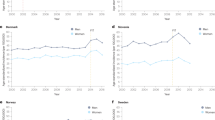Abstract
There is no direct evidence that colonoscopy screening reduces mortality from colorectal cancer. However, results from studies using fecal occult blood testing and sigmoidoscopy, along with the fact that colonoscopy is performed after positive primary screening tests, support this assumption. Colonoscopy every 10 years is the preferred strategy in terms of clinical outcomes and cost effectiveness. The purpose of this article is to present the methodology used for the implementation of an opportunistic colonoscopy colorectal cancer screening program in Poland. We also review recent literature on challenges related to colonoscopy screening including recruitment, acceptance, and quality of the procedure.
Similar content being viewed by others
References and Recommended Reading
Winawer SJ, Zauber AG, Ho MN, et al.: Prevention of colorectal cancer by colonoscopic polypectomy. N Engl J Med 1993, 329:1977–1981.
Mandel JS, Bond JH, Church TR, et al.: Reducing mortality from colorectal cancer by screening for occult blood. N Engl J Med 1993, 328:1365–1371.
Butruk E, Regula J, Polkowski M, et al.: National colorectal cancer screening programme in Poland. Endoscopy 2002, 34:939–940.
Corbett M, Chambers SL, Shadbolt B, et al.: Colonoscopy screening for colorectal cancer: the outcomes of two recruitment methods. Med J Aust 2004, 181:423–427.
Rozen P, Blanchard J, Campbell D, et al.: Implementing Colorectal Cancer Screening: Group 2 Report. ESGE/UEGF Colorectal Cancer Public Awareness Campaign. The Public/Professional Interface Workshop: Oslo, Norway, June 20-22, 2003. Endoscopy 2004, 36:354–358.
Keighley MR, O’Morain C, Giacosa A, et al.: Public awareness of risk factors and screening for colorectal cancer in Europe. Eur J Cancer Prev 2004, 13:257–262.
Ioannou GN, Chapko MK, Dominitz JA: Predictors of colorectal cancer screening participation in the United States. Am J Gastroenterol 2003, 98:2082–2091. This paper reports the results of a population survey on participation in CRC screening in the United States. Differences were found depending on gender, race, ethnicity, age, education, income, health coverage, and having a usual source of care.
Farraye FA, Wong M, Hurwitz S, et al.: Barriers to endoscopic colorectal cancer screening: are women different from men? Am J Gastroenterol 2004, 99:341–349.
Menees SB, Inadomi JM, Korsnes S, et al.: Women patients’ preference for women physicians is a barrier to colon cancer screening. Gastrointest Endosc 2005, 62:219–223.
Imperiale TF, Wagner DR, Lin CY, et al.: Using risk for advanced proximal colonic neoplasia to tailor endoscopic screening for colorectal cancer. Ann Intern Med 2003, 139:959–965.
Anderson JC, Alpern Z, Messina CR, et al.: Predictors of proximal neoplasia in patients without distal adenomatous pathology. Am J Gastroenterol 2004, 99:472–477.
Schoenfeld P, Cash B, Flood A, et al.: Colonoscopic screening of average-risk women for colorectal neoplasia. N Engl J Med 2005, 352:2061–2068. This study has shown that although the prevalence of advanced colorectal neoplasia among screened women was lower than the prevalence among men, FS is an inadequate method of predicting advanced neoplasia in the proximal colon in women, and women would benefit more from colonoscopic screening than would men.
Rex DK, Cutler CS, Lemmel GT, et al.: Colonoscopic miss rates of adenomas determined by back-to-back colonoscopies. Gastroenterology 1997, 112:24–28.
Pickhardt PJ, Nugent PA, Mysliwiec PA, et al.: Location of adenomas missed by optical colonoscopy. Ann Intern Med 2004, 141:352–359. CT colonography used to assess adenoma miss rate in optical colonoscopy showed that 12% of polyps greater than 10 mm were missed.
Atkin W, Rogers P, Cardwell C, et al.: Wide variation in adenoma detection rates at screening flexible sigmoidoscopy. Gastroenterology 2004, 126:1247–1256. Adenoma detection rate varies significantly among endoscopists and may be used as a quality measure.
Ramakrishnan K, Scheid C: Selecting patients for flexible sigmoidoscopy. Determinants of incomplete depth of insertion. Cancer 2005, 103:1179–1185.
Pabby A, Schoen RE, Weissfeld JL, et al.: Analysis of colorectal cancer occurrence during surveillance colonoscopy in the dietary Polyp Prevention Trial. Gastrointest Endosc 2005, 61:385–391. The rate and reasons of colonoscopically missed cancers are analyzed in this article. In at least 50% of cases, a better technique of colonoscopy would allow for earlier detection of missed cancers.
Nelson D, McQuaid KR, Bond JF, et al.: Procedural success and complications of large scale screening colonoscopy. Gastrointest Endosc 2002, 55:307–314.
Author information
Authors and Affiliations
Corresponding author
Rights and permissions
About this article
Cite this article
Regula, J., Zagorowicz, E. & Butruk, E. Implementation of a national colorectal cancer screening program. Curr colorectal cancer rep 2, 25–29 (2006). https://doi.org/10.1007/s11888-006-0014-y
Issue Date:
DOI: https://doi.org/10.1007/s11888-006-0014-y




